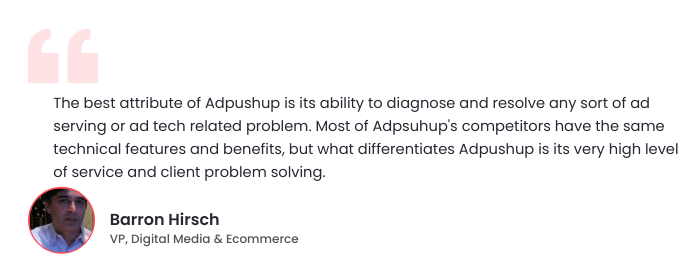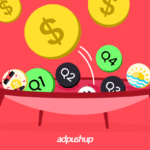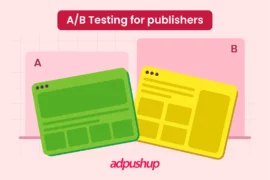Read out blog to know the actionable ways to increase ad revenue and bet the Q1 slump!
Is your revenue graph stuck in a downward trend? Don’t worry; at some point or another, every publisher faces this problem. It’s not the end of the world. It just means that you need to buckle down, reevaluate your content and ad strategy, eliminate things that aren’t working, and do more of what is.
If you are looking to manage your ad revenue drop, you are at the right place. Let our blog be a checklist for you to reassess your ad strategies. Moreover, we will also be discussing the top reasons that are killing your ad revenue.
How to Increase Ad Revenue?
Q1 is the time when publishers face a slump in their ad revenue post-Q4 revenue surge. eCPMs drop, ad impressions take a hit, and website traffic sees a dip.
Fret not; we have identified some of the best ways to improve ad revenue for you.
First let’s address the elephant in the room – ad-specific tactics to manage your ad revenue drop.
1. A/B Test your Ad Units
Q1 is the time you can run A/B tests to identify the best layout for your website. Test various ad formats, ad sizes, and their placements to decide which one works the best for you.
Keep track of the following metrics to do the same: CTR (click-through rate), ad visibility, time spent on a page, and impressions.
2. Implement Flexi-floor Pricing
You cannot expect the same Q4 revenue in Q1, which is quite understood as Q4 was the holiday season – when all advertisers would go into a frenzy with their budgets.
A thorough A/B testing will help you identify the revenue-generating ad units to set a higher floor price for them. Accordingly, adjusting your floor price for all your ad units will help you match advertisers and generate more ad revenue.

3. Experiment with Ad Formats and Ad Sizes
A dwindling ad revenue calls for new ad formats and ad sizes. Try your hands on ad formats like video ads, interstitial ads, or pop-up ads. You can also consider implementing native ads or even rich-media banner ads.
As for ad sizes, opt for multi-ad size slots. For example, the large rectangle can be placed in both 336×280 and 300×250 slots. Similarly, the wide skyscraper can be placed in both 160×600 and 120×600 slots. The same happens for half-page ads. Some other revenue-generating ad sizes also include leaderboard and medium rectangle.
4. Go for Header Bidding
Another actionable way to increase ad revenue is to implement header bidding. If you have already implemented header bidding, you can move to the next point. But if you haven’t, read on. Unlike the waterfall method, header bidding allows advertisers to bid simultaneously on an impression. This creates bid pressure on the impression and, in turn, provides higher eCPMs to the publishers.
For apps, we have in-app header bidding for their monetization. The process is simple: it just takes a line of code to set up header bidding.
AdPushup offers header bidding to their publishing partners. With 50+ premium demand partners, we guarantee an increased yield.
5. Implement Ad Refresh
Ad refresh allows the ad to get refreshed after a set time interval. This enables you to display more ads in a single slot. Hence, revenue per session will increase without adding new ad units. The biggest advantage that ad refresh offers is that it negates negative user experiences.
For starters, 30-60 seconds is the industry standard, but you can adjust it according to your content. For time-based triggers, Google allows a minimum of 30 seconds, while 60 seconds is advised as best practice.
For example, pages with long-form content may benefit from slower refresh rates, but shorter content may allow for more frequent refreshes (ad frequency) based on user engagement.
But do check with your demand partner. For example, Google AdSense and Magnite don’t allow auto-ad refresh. On the other hand, Google AdX and OpenX allow it.
Now, let’s cover the website-specific tactics.
6. Improve your Website SEO
When we talk about SEO, we consider all the facets – On-page, Off-page, Technical, Local, International, and White Hat.
The first thing you should do is check for 404 errors and broken links. These can have a huge impact on your website. Let us share an instance with you. One of our blogs targeting an important keyword was showing a 404 error, which caused its ranking to drop from 8th to 15th. As soon as we fixed it, we regained the ranking, and it kept improving.
A few publishers may even consider applying Black hat SEO to tackle the revenue drop. Avoid it at any cost. Google rankings are still volatile, and any violation can penalize your website.
You can also double down on your backlinking efforts. Getting backlinks from credible websites will certainly help you sail through turbulent times.
7. Work on your Content Quality
Identify conversion/traffic-driving keywords and work on them. This can include updating the content or pruning it, including new keywords that your competitors are ranking on, and so on.
Most importantly, align your content strategy with the ongoing market trends. Though, we don’t have to focus much on this; we trust your expertise. But as a gentle reminder, focus on identifying new topics that you can cover. And regularly update your old pages to make them fresh and relevant for the readers. Create content using keywords with high search volume and low competition.
High-quality content will drive traffic, which inevitably will convert into ad impressions and more clicks. The more relevant your website will be in the eyes of users, the higher your rankings will be. And the cycle will continue.
8. Improve the Website Speed
Website latency can cost you viewers. Over time, the impact can be seen not just on traffic but also on your rankings. According to statistics, 40% of visitors will quit a website that takes more than 3 seconds to load. Moreover, even a single-second delay can reduce viewer satisfaction by 16% (BrowserStack).
There are many initiatives that you can implement to tackle slow website speed: implement lazy loading, optimize images by reducing their size, reduce redirects, and implement website caching.
You can also implement various HTML attributes like preconnect, prefetch, preload, or even dns-prefetch to help with data loading.
9. Optimize your Website for Mobiles
This is a very important factor in the decline of your ad revenue. Mobile devices currently account for more than 55% of global website traffic, with 74% of consumers revisiting mobile-friendly websites (WebStack).
You can use responsive design for ads to display seamlessly on mobile. On top of that, you can also work on simplifying the navigation in the mobile version of your website. As a matter of fact, simplifying the navigation and using clear design segments can do wonders for your website.
Let’s now finally take a look at the factors that might be killing your ad revenue.
Factors Impacting your Ad Revenue
Many factors can impact your ad revenue. And these factors become equally crucial during Q1. Here are some factors that can be checked while looking for revenue leakages:
1. Poor Ad Placements
One of the foremost ad revenue killers is poor or intrusive placements. The performance of your campaigns depends a lot on where and how you place your ads on a webpage.
Efficient ad placements improve your website’s user experience and increase your ad revenue. Poorly executed placements, on the other hand, ruin a website’s interface, alienate users, and, more often than not, lead to low impressions and clickthrough rates.
Selecting an ad layout that works is not as simple as picking the three most popular ad units and hoping it’ll work; what works for someone else’s website may not necessarily work for yours.
For example, adding too many interstitial ads to your website can make the ad experience intrusive for the users. At the same time, placing too many ads above the fold can hamper the very purpose of your website.
2. Low-quality Ad Creatives
Before working on your ad placements, you should focus on your ad creatives. As much as ad placements are important, ad creatives can equally make or break ad campaigns or even website reputation.
Ad creatives should play around the relevance of the product/brand and the website where they will be placed, as high-end publishers can get picky about the ads they display. Not writing concise, to-the-point copies or using clear CTA (Call-to-action) can turn off the viewers. Even if you nail the ad copies, failing to use high-quality and relevant graphics can mark a dent in your ad creatives.
3. Slow Page Load Times
Another important reason behind your ad revenue drop can be slow page load times or high page latency.
For publishers, high page latency equates to losing viewership and a drop in traffic. Even Google can derank your website if it has a slow page load time. On top of that, a website’s bounce rate also increases as it takes longer to load.A high bounce rate tells search engines that visitors don’t find the page’s content useful, causing a decline in ranking.
As you can observe, all factors are interlinked. Hence, page latency should be one of the non-negotiable factors while improving your ad revenue drop.
4. Ad Blockers Are Eating Into Your Revenue
Ad blockers have been slowly gaining momentum over the years, and its adoption rate in the last few years has been nothing short of alarming. According to MediaPost, almost $54 billion has been lost in ad revenue in 2024, a number that represents 8% of total ad spend.
While ad blocking is a convenient solution to a pesky problem (slow, intrusive, bloated ads) for users, it’s also something that threatens the very existence of many publishers.
5. Lack of Audience Targeting
Lack of audience targeting can take a toll on your marketing budget. It can even hamper the brand identity of the publisher’s website. Imagine this: A pedigree brand is displaying its ads on a sports website. Or a website that mainly caters to fashion enthusiasts.
While some may justify it with their target users visiting these websites, would the ROI be justified? Although you can also consider it a retargeting tactic, the ROI ratio won’t justify the campaign investment. Not to mention the hit the brand reputation of the website would be taking.
It is here audience targeting comes into the picture. As an advertiser, it’s best to revisit your audience targeting segments, study the trends, and make changes accordingly.
6. Compare Ad Networks
Rather than relying on a single ad network, you can experiment with various ad networks and demand partners for ad revenue optimization. Ad networks play an important role in determining the type and relevance of ads that are displayed on your website.
So, if you test different ad networks with the ad size and position being constant for a unit, you can actually measure and see which network is performing better (in terms of total income CTR & eCPM) over time.
You can also partner with ad revenue optimization platforms like AdPushup to increase your ad revenue in Q1. We guarantee a revenue uplift by at least 30%.
Increase Ad Revenue: Key Takeaways
1. Work on your Website SEO: Boost backlinking activity, align the content with latest trends, fix broken links and 404 errors. Reduce website latency to avoid traffic drop.
2. Polish the Content quality: Add new keywords, revamp the old content, and identify new topics to cover.
3. Optimize for Mobile: Use mobile-friendly navigation and responsive design
4. A/B testing: Experiment with ad layouts, formats, and placements.
5. Use Flexi-floor Pricing and Compare Ad Networks: Adjust floor price according to the seasonal trends to capture advertiser demand. Compare ad networks to see which one suits you the best.
6. Consider Header Bidding and Ad Refresh: Implement these to increase eCPMs and revenue.
FAQs on Increase Ad Revenue
There can be many reasons behind decreasing AdSense revenue: Recent switch from CPM to CPC model, poorly-placed ads (leads to banner blindness) or irrelevant ads, high invalid clicks, etc.
It is a data-driven strategy used by marketers to extract the maximum value from their digital assets. In this case, its publishers and ad inventory. It’s done by adjusting the floor price, partnering with multiple ad networks, A/B test ad placements, etc.






